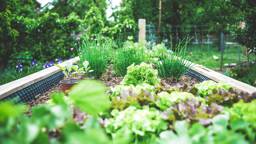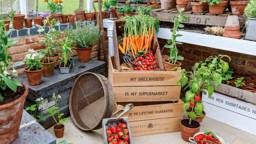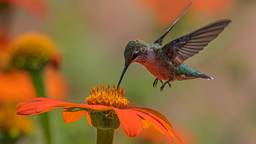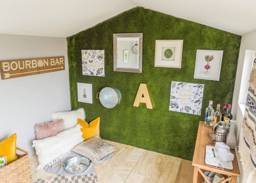Every year, between mid-May and September, travelers from around the world flock to Denali National Park and Preserve, carrying high hopes for clear skies to catch a glimpse of North America’s tallest peak, Mt. McKinley.
Mt. McKinley can be elusive, on some days showing its face in full glory, and on others, stubbornly enrobed in the clouds. But even if the weather isn’t cooperating, there’s a different breathtaking view a mile down the road at Denali Princess Wilderness Lodge.
An Extraordinary Garden
A virtual wonderland of flowers thrive throughout this property. Hundreds of brilliant hanging baskets, whiskey barrels and planters are packed with colorful annuals that burst forward like fireworks. Dazzling tuberous begonias with six-inch flower heads and dahlias the size of dinner plates are a common – yet, nonetheless astonishing – sight. Waves of neon petunias flow out of their containers and sweep the ground. Creeping jenny weeps off cottage roofs in the resort village. Black-eyed susans, ‘snowland’ chrysanthemums, tiny ‘lulu’ marigolds, hot orange nasturtiums, soft blue ageratum, and brightly hued coleus – the list goes on. It’s enough to make any garden hobbyist swoon … and use all of her camera’s digital memory to capture the spectacular display.
Who is behind this horticultural magic? It's Ryan Douglas, a landscape gardener from Minnesota who lives for five months in the little cabin featured on page 35 of the August 2011 issue.
Douglas arrives a few weeks before guests and installs nearly 200 hanging baskets that are started months earlier at a greenhouse in Fairbanks. He brings the rest of the containers back to life, designing and planting floral combinations in harmonious colors, then coaxing them into full performance throughout the Lodge’s short summer.
Mt. McKinley can be elusive, on some days showing its face in full glory, and on others, stubbornly enrobed in the clouds. But even if the weather isn’t cooperating, there’s a different breathtaking view a mile down the road at Denali Princess Wilderness Lodge.
An Extraordinary Garden
A virtual wonderland of flowers thrive throughout this property. Hundreds of brilliant hanging baskets, whiskey barrels and planters are packed with colorful annuals that burst forward like fireworks. Dazzling tuberous begonias with six-inch flower heads and dahlias the size of dinner plates are a common – yet, nonetheless astonishing – sight. Waves of neon petunias flow out of their containers and sweep the ground. Creeping jenny weeps off cottage roofs in the resort village. Black-eyed susans, ‘snowland’ chrysanthemums, tiny ‘lulu’ marigolds, hot orange nasturtiums, soft blue ageratum, and brightly hued coleus – the list goes on. It’s enough to make any garden hobbyist swoon … and use all of her camera’s digital memory to capture the spectacular display.
Who is behind this horticultural magic? It's Ryan Douglas, a landscape gardener from Minnesota who lives for five months in the little cabin featured on page 35 of the August 2011 issue.
Douglas arrives a few weeks before guests and installs nearly 200 hanging baskets that are started months earlier at a greenhouse in Fairbanks. He brings the rest of the containers back to life, designing and planting floral combinations in harmonious colors, then coaxing them into full performance throughout the Lodge’s short summer.
Expert Gardening Tips You Can Use
Can every gardener have such beautiful results – even without the 20-plus hours of reflected light found in the “Land of the Midnight Sun?" Douglas says yes, it is possible and generously shared these tips for designing and caring for your own show-stopping containers:
Select plants that will do best in your summer climate zone. Visit your extension service, parks and recreation department, or ask at your nursery or public gardens. “Ideas are everywhere, all you need to do is look and ask,” says Douglas.
Use new top-quality potting soil each year. “Dig out half of last year’s soil, add new, and mix it into the existing soil,” Douglas advises. Also, sprinkle cottonseed meal and bone meal over the soil to ensure good root development.
Keep it simple. Design each container with no more than three to five choices; include one taller upright plant to fill the center. Everything else fits the “trailing” category (creeping charlie and jenny petunia) or “billowy” category (lulu marigold, pansy, snowland chrysanthemum.)
Can every gardener have such beautiful results – even without the 20-plus hours of reflected light found in the “Land of the Midnight Sun?" Douglas says yes, it is possible and generously shared these tips for designing and caring for your own show-stopping containers:
Select plants that will do best in your summer climate zone. Visit your extension service, parks and recreation department, or ask at your nursery or public gardens. “Ideas are everywhere, all you need to do is look and ask,” says Douglas.
Use new top-quality potting soil each year. “Dig out half of last year’s soil, add new, and mix it into the existing soil,” Douglas advises. Also, sprinkle cottonseed meal and bone meal over the soil to ensure good root development.
Keep it simple. Design each container with no more than three to five choices; include one taller upright plant to fill the center. Everything else fits the “trailing” category (creeping charlie and jenny petunia) or “billowy” category (lulu marigold, pansy, snowland chrysanthemum.)
Use bright colors. Create harmony with bright red, orange and yellow, and accent with blue and yellow mini-flowers. Rudbeckia (Indian summer), grown as an annual and planted with a ring of lulu marigolds, looks stunning and bright. Combine upright tuberous begonias with nonstop and wax begonias and you'll have great flowerbed partners.
Busy designs can be color-corrected with white. “I use snowland chrysanthemum often for this purpose – white is a unifying color,” Douglas says. “Mix white with annual dianthus and portulaca and you’ll have an instant meadow!”
Don't forget foliage. Leaves add color to flowers that will come later. Salmon-colored coleus looks great with begonia flowers that bloom the same color later in the season.
Think texture and color. Combine bold-leaf plants with fine-textured plants to create big impact. “Try cosmos bipinnatus with flowering kale and red nasturtium with blue pansies and snowland chrysanthemum,” advises Douglas.
Busy designs can be color-corrected with white. “I use snowland chrysanthemum often for this purpose – white is a unifying color,” Douglas says. “Mix white with annual dianthus and portulaca and you’ll have an instant meadow!”
Don't forget foliage. Leaves add color to flowers that will come later. Salmon-colored coleus looks great with begonia flowers that bloom the same color later in the season.
Think texture and color. Combine bold-leaf plants with fine-textured plants to create big impact. “Try cosmos bipinnatus with flowering kale and red nasturtium with blue pansies and snowland chrysanthemum,” advises Douglas.
Go the natural way. Mix feathery grasses with bold formal flowers like stiff dahlias and soften the edge with trailing verbena or pansies.
Recognize a garden is never done. “Study your combinations and don’t be afraid to take away selections that aren’t working and add in flowers that will,” counsels Douglas. “Sometimes, pushing plants aside in the pot and tucking in one or two other choices can take your containers from boring to botanical overnight. Gardening is a trial!”
Less is more when fertilizing. Start larger plants with vitamin B-1 transplant solution. Then, begin feeding with an alternating watering schedule of diluted fish emulsion and Miracle Grow. Smaller plants will respond to the fish emulsion.
Cluster containers around an object you wish to highlight. A garden bench, an entryway, dotted along pathways, anywhere you want to say “hi!” with color.
Become a companion to your plants as they grow. “Dead-heading, fertilizing and maintenance need not be a chore – it’s wonderful time spent in the garden and good for the soul,” offers Douglas. And to make that time work best for you, he advises, “You create the schedule.”
Robyn Roehm Cannon wishes she could get it to stop raining in Seattle, so her own garden just might have a chance!
Recognize a garden is never done. “Study your combinations and don’t be afraid to take away selections that aren’t working and add in flowers that will,” counsels Douglas. “Sometimes, pushing plants aside in the pot and tucking in one or two other choices can take your containers from boring to botanical overnight. Gardening is a trial!”
Less is more when fertilizing. Start larger plants with vitamin B-1 transplant solution. Then, begin feeding with an alternating watering schedule of diluted fish emulsion and Miracle Grow. Smaller plants will respond to the fish emulsion.
Cluster containers around an object you wish to highlight. A garden bench, an entryway, dotted along pathways, anywhere you want to say “hi!” with color.
Become a companion to your plants as they grow. “Dead-heading, fertilizing and maintenance need not be a chore – it’s wonderful time spent in the garden and good for the soul,” offers Douglas. And to make that time work best for you, he advises, “You create the schedule.”
Robyn Roehm Cannon wishes she could get it to stop raining in Seattle, so her own garden just might have a chance!
 Laurent Dick
Laurent Dick 
 Laurent Dick
Laurent Dick 









